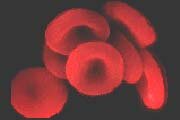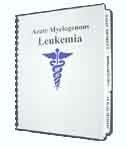 |
||
| HOME | ||
 |
||
| Acute Myelogenous Leukemia (AML) |
||
 |
||
| Other Leukemia Types (ALL / CLL / CML / HCL) |
||
 |
||
| Myelodysplastic Syndrome | ||
 |
||
| Symptoms and Diagnosis | ||
 |
||
| Leukemia Treatment Options | ||
 |
||
| " Chemotherapy | ||
 |
||
| " Blood Stem Cell Transplants | ||
 |
||
| " Radiation and Surgery | ||
 |
||
| " Chemo Side Effects | ||
 |
||
| " Clinical Trials Info | ||
 |
||
| " Coping with Leukemia | ||
 |
||
| " What to Ask Your Doctor | ||
 |
||
| Financial Assistance | ||
 |
||
| At Risk Jobs/Exposure | ||
 |
||
| Leukemia Resources | ||
 |
||
| Survivor's Story | ||
 |
||
| Leukemia News | ||
 |
||
|
Search for information:
|
||

|
Leukemia Cancer News - Return to Menu Healthbeat: Bone Marrow Blood Test March 28, 2005 Leukemia According to the Leukemia and Lymphoma Society, about 33,440 new cases of leukemia will be diagnosed in the U.S. this year. Acute lymphocytic leukemia accounts for about 3,830 cases of leukemia every year. It is the most common form of leukemia in children. Incidence is nine times higher in children one to four than in those 20 to 24. The other types of leukemia are most commonly diagnosed in late adulthood. About 11,920 cases of acute myelogenous leukemia are diagnosed annually. Annual incidence of chronic lymphocytic leukemia is about 8,190 cases and for chronic myelogenous leukemia, about 4,600 cases. Lymphoma About 62,250 cases of lymphoma will be diagnosed this year in the U.S. Roughly 7,880 cases are of Hodgkin lymphoma. Its slightly more common in males than in females. Non-Hodgkin lymphoma is slightly more common than Hodgkin lymphoma. About 54,370 cases will diagnosed this year. As with Hodgkin lymphoma, males are affected slightly more often than females. Leukemia and Lymphoma: Testing and Follow-up The most common site for bone marrow testing is the hipbone (posterior iliac crest). The skin in the area is cleaned and the patient is given a local anesthetic. Once the area is anesthetized, a small incision is made into the skin. A sharp, hollow needle is inserted through the incision, then into the bone. One of two types of tests may be performed. A bone marrow aspirate uses a syringe to withdraw a small amount of liquid within the bone marrow. This test is used to determine what types and how many blood cells are present in the bone marrow. The second test is a bone marrow biopsy. A slightly larger needle is inserted through the same space. The needle is rotated to cut and obtain a small specimen of bone. The needle is withdrawn and the bone sample is removed for analysis. A bone marrow biopsy can be used to look at the structure of the bone marrow. After bone marrow aspiration and biopsy, a bandage is placed over the site to control bleeding. Patients may experience some degree of pain and discomfort after the procedure. There is also a risk of persistent bleeding and infection. A Bone Marrow Blood Test But the days of frequent bone marrow testing may soon be over. Researchers at the University of Texas M.D. Anderson Cancer Center have developed a blood test that may provide much of the information obtained from the traditional bone marrow test. The blood test looks for molecular signs of the cancer within the blood. Researchers will look for the presence of certain proteins expressed on the surface of tumor cells, namely CD20, CD33 and CD52. In addition, the test will screen blood plasma for evidence of RNA and DNA that are specifically linked to leukemia and lymphoma. The new blood test may not entirely replace the need for bone marrow testing. Researchers are hopeful it will greatly reduce the need for patients to undergo the painful traditional method of testing. The blood test has been licensed to Quest Diagnostics, Inc. Researchers hope it could be available by the end of the year. For information about the test: For information on leukemia and lymphoma: Battle of a Lifetime Burlington, Vermont - July 14, 2005 - Little Alex Johnson told her parents someday she'd be a pediatric oncologist. "I wanted to help people with leukemia because I wanted to help kids. I did report on it when I was in third or fourth grade." But the disease Alex wanted to treat, is now the one she's fighting. Alex was on spring vacation with her mom when started to feel sick. "I'm a nurse and I knew when her gums started to bleed that she had something serious," Lisa Johnson, Alex's mom said. So they went to the hospital. "They did some blood tests and found my white blood cell count was 89,000 when the normal amount is between 8,000 and 13,000." Doctors diagnosed the happy-go-lucky teen with acute myeloid leukemia a tough form of the disease to treat. "AML counts for about 15 percent of childhood leukemia. In a center like this we see 2 to 3 children a year with this," Dr. Alan Homans, director of pediatric oncology said. Although everyone at the hospital admits Alex is one of a kind. Long before the diagnosis, the 13-year-old was growing out her hair so she could donate it to cancer patients. Chemotherapy has put that project on hold for now. "At this point it looks like she may not need a bone marrow transplant because she is responding so well to chemo," Dr. Homans said. "I don't think it's that bad because I see a lot of other people and it could be worse. I'm lucky ... I think," the teen said. But the girl who thinks about everyone is experiencing what it's like to have everyone think about her. "People are bringing food, two meals a day, there's a donation jar in every store in S. Burlington," Lisa said. The Johnsons are touched by the community's support. Friends made a photo collage for Alex and local businesses are doing whatever they can to raise funds for the family. "I'm out of work not to stay with Alex and with the two kids. And Jim works for himself so he's not working as much. So there's an decrease in our income," Lisa said. Alex says she's not scared and that having a positive attitude is important. She had a fever when we met her, but she never stopped smiling. And as far as what she wants to be when she grows up? "I'm pretty sure a pediatric oncologist..."I think it will be easier being a pediatric oncologist if I know all this stuff now." Her family says they know when that day comes her patients will be the lucky ones. To find out a more information on the national donor program call 1-800-marrow2 Jessica Abo -- Channel 3 News. |
|
|


